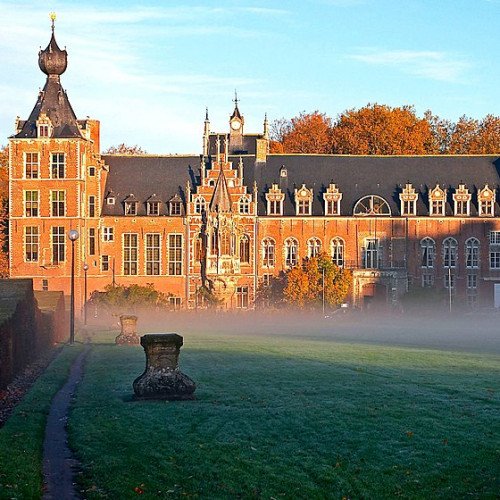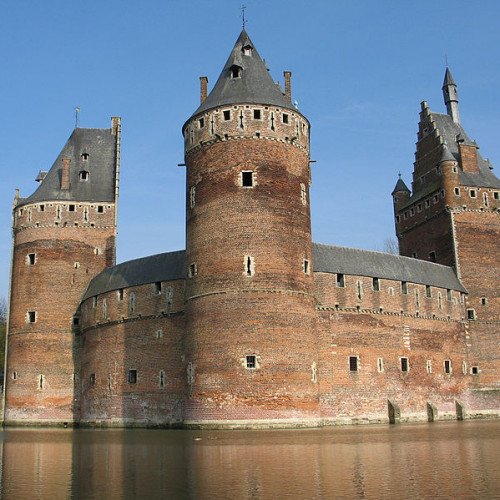Castles of "Belgium" KASTEEL VAN ARENBERG vs BEERSEL CASTLE

KASTEEL VAN ARENBERG
Arenberg Castle (Dutch: Kasteel van Arenberg, French: Château d'Arenberg) is a château in Heverlee close to Leuven in Belgium. It is surrounded by a park. The site had been the castle of the lords of Heverlee since the 12th century, but this family became impoverished and had to sell the site in 1445 to the Croÿ family from Picardy. Antoine I de Croÿ demolished the medieval castle and started works to build the current château in 1455 on the site, of which he destroyed all but one tower. His grandson, William de Croÿ, completed the works on the château in 1515, and founded a monastery on the château grounds for the Benedictine Celestines. The architectural style is in large part traditionally Flemish, with sandstone window frames and brick walls, though it has been structurally altered since 1515 and has elements of Gothic, Renaissance, and Neo Gothic architecture. Its large corner towers are typical, once surmounted by a German eagle. Charles III of Croy was the 4th and last duke, and after his death in 1612 without issue the château passed to the Arenberg family into which his sister had married, and remained in that family until the First World War. Even before the First World War, the 8th duke of Arenberg wanted to sell the château and its grounds to the Catholic University of Leuven, for a reasonable price. During the First World War, the château and grounds were occupied by the Germans and Austrians. The château and park were seized by the Belgian government on the outbreak of, and then after the war since the Arenberg family was considered to be German or Austrian due to their close Habsburg connection, monarchs of Austria-Hungary. It took until 1921 for the University to acquire them, becoming an expanded natural sciences and engineering campus in the style of that of an American university. After the partitioning of the university along language lines in 1968, the château and grounds remained with the Dutch speaking half as one of the main campuses for the new, independent Katholieke Universiteit Leuven. The château itself is the main building of the Faculty of Engineering and houses lecture rooms and studios for the Department of Architecture, Urbanism and Urban Planning, including the Post-Graduate Centre Human Settlements and the Raymond Lemaire International Centre for Conservation (named after Raymond M. Lemaire). The building is open to the public. The former Celestine monastery on the château grounds now houses the campus library, and the addresses of many of the science buildings are on the street named Celestijnenlaan (Dutch for "Celestine Street").
Statistics for this Xoptio

BEERSEL CASTLE
Beersel Castle (Dutch: Kasteel van Beersel) is a medieval castle located in Beersel, Flemish Brabant in Belgium. Originating in 1300 under the auspices of the Duchy of Brabant, the water castle's present configuration dates to 1357. It was twice sacked and was subject to significant restorations in 1491 and 1617. Its present condition owes much to a major restoration in 1928–39. Built largely of brick, a rare material for such buildings at the time, around a circular enceinte, its major feature is its three large towers. Today it is open to the public and is considered one of Belgium's best-preserved castles. Beersel was located at the frontier of the Duchy of Brabant within the County of Hainaut, south-west of Brabant's principal city of Brussels and near Halle. A fortified residence at the site was attested as early as 1292. In 1300, however, Godefroid of Hellebeke, the first known Seigneur of Beersel, received permission from Jean II, Duke of Brabant, to build a fortification on the present site near his residence. It became one of several Brabantine fortifications in the area, including Gaasbeek Castle. In 1356, during the War of the Brabant Succession (1356–57), the original castle was besieged by soldiers from the County of Flanders, led by Louis of Male who captured and sacked it. Beersel Castle was rebuilt from 1357 with a circular enceinte. It had three large and one small tower. During the 14th century, ownership of the castle passed to the Seigneurs of Wittem (Witthem). Henry III of Wittem supported Emperor Maximilian during the revolts of 1483–1492, placing him at odds with Brussels which supported the rebellion. Beersel Castle was besieged by Brussels militias twice in 1488 and 1489. During the second siege, the castle was attacked with cannons provided to the rebels by Louis XI of France and fell after several days, sustaining significant damage especially at its southern side.